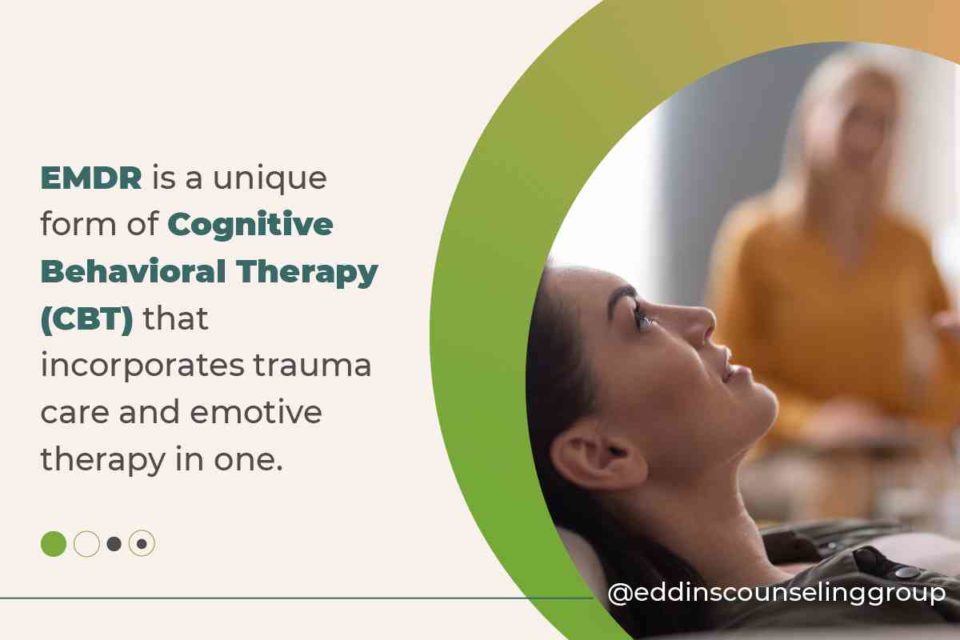December 19, 2022
A Comprehensive Guide to EMDR Therapy
Written by Sara Lane
Posted in Emotional & Mental Health, Trauma, Grief & Loss and with tags: EMDR, PTSD/Trauma, abuse, brainspotting

EMDR Therapy, also known as Eye Movement Desensitization & Reprocessing, is a unique form of Cognitive Behavioral Therapy that incorporates trauma care and emotive therapy in one.
With a long standing history of success for treating clients with trauma, distressing memories, or PTSD, eye movement desensitization and reprocessing has shaped the way therapists approach trauma care.
In fact, some studies have shown a 77% success rate in clients suffering from traumatic mental health conditions like PTSD.
If you’re wondering if EMDR might be for you, read on to discover its uses, benefits, and implementation.

What is EMDR and How Does It Work?
EMDR Therapy, also known as Eye Movement Desensitization & Reprocessing, is a unique form of Cognitive Behavioral Therapy that incorporates trauma care and emotive therapy in one.
EMDR was first founded by Francine Shapiro, Ph.D in 1987. After walking in the park, she noticed that the side to side movements she was making were decreasing her own distressing memories.
After further research, she found that eye movement with the other treatment elements could actually impact the nature of the memory itself.
By doing this, she created the therapeutic procedure she called Eye Movement Desensitization (EMD).
Case studies and controlled groups tested the working effectiveness of EMD. With half of her participants receiving treatment, she found that EMD significantly improved how the clients processed and understood the trauma.
Clients reported less distress and significantly higher levels of confidence and positive beliefs. In fact, clients reported less distress over their traumatic memories in just one session.
EMDR: Revolutionizing Trauma Therapy
As clients continued to find positive and effective results from using EMD therapy, this procedure began to gain ground.
In 1991, Shapiro changed the name to Eye Movement Desensitization & Reprocessing (EMDR) to showcase the change that occurs over the course of treatment.
The process of remembering, desensitizing, and reprocessing trauma has led to a worldwide movement that revolutionized trauma therapy care.
EMDR is now a nationally recognized therapeutic intervention, with its primary goal to “establish, maintain, and promote the highest standards of excellence and integrity in Eye Movement Desensitization and Reprocessing (EMDR) practice, research, and education”.
Innovative discoveries are still being made in the field of psychotherapy, but the grounding science of EMDR has been a great source of improvement for many clients with PTSD and trauma.

EMDR for Anxiety and Other Conditions
Not everyone who tries EMDR has a significant trauma disorder (like Post Traumatic Stress Disorder, or PTSD).
Clients who try EMDR therapy come with a wide range of mental health symptoms, including:
- Anxiety
- Difficulty concentrating
- Panic attacks
- Feeling withdrawn from friends or family
- Intrusive thoughts or flashbacks
- Dissociation
- Irritability
- Feeling triggered by one’s emotions
- Feeling disconnected from one’s body
- Feeling disconnected from the world around them
- Mental numbness
- Mood swings that make them feel out of control
- Hypervigilance (feeling that one has to be “on guard” against threats all or most of the time)
- Chronic pain
- Abuse
- Trauma
- Post traumatic stress disorder (PTSD)
- Inability to feel safe in their environment
- Anger outbursts
Whether you have specific distressing memories in mind that you’d like to work on or you’re questioning whether EMDR is right for you, chances are you can benefit from EMDR.
You may not have a diagnosis, and that’s ok. Your interest in EMDR is valid and you can access EMDR therapy without having a pre-existing mental health disorder.
What to Expect
The process of EMDR therapy can be anywhere from 8-12 sessions or longer depending on the depth of the trauma experienced. Some clients report sensing a significant improvement in their mental health within the first 3-5 sessions.
No matter how long the process takes for you, your therapist will walk you through all that you need to know about EMDR and what to expect.
While you and your therapist will talk about the traumatic events, your therapist will attempt to discuss it with you in a way that does not overwhelm you.

The Phases of EMDR Therapy
Eye Movement Desensitization and Reprocessing (EMDR) Therapy has eight distinct phases that work to reprocess trauma and improve quality of life. Each stage is an essential part of restoring functioning.
1 Treatment Planning
The initial stage of therapy is to take stock of what brings you to therapy and what your goals are. These goals could be as simple as “not feeling so anxious 24/7” or “being able to enjoy time with my family again”.
Your therapist will walk you through the entire process, taking into consideration your feelings and stage of trauma. If you don’t feel that trauma is a part of your story, your therapist may walk you through other patterns of mistrust, pain, or loss.
Each person’s story is unique. This means that what goals you set may not be the goals that others would set for you. And that’s ok.
The EMDR experience is meant to be a personalized experience that focuses on you. You and your therapist will discuss goals for treatment together and create a plan for the change you want to see.
2 Preparation
During this stage, you and your therapist will get to know each other. You’ll talk about what is working well in your therapeutic relationship and ways that your therapy could be improved.
It may take time to feel comfortable with your therapist, and that’s normal. In the meantime, speak up if something isn’t working or making you uncomfortable.
Additionally, your therapist may offer some new coping mechanisms, mental “safe spaces”, and other important tools to prepare you for EMDR work.
3 Assessment
During this stage, you and your therapist will identify the event you want to process. This pain point can be a time in your life that really impacted you in a significant way.
This event may be an outwardly positive event to others (parents getting re-married, moving to a new environment, going to college).
However, even if others view the event as a positive experience, your feelings are (your pain is) valid. The fact that this event was painful and potentially traumatizing is enough.
Your therapist’s goal is to make the event less stressful and traumatizing.
This may feel impossible: you may even feel as though this particular event is so awful that you’ll never feel differently. Despite the pain you have experienced, there is an opportunity to heal.
You may not get back to being the same person you were before the event, but you may become an even stronger person than you were before.
Take your time on this journey.
4 Desensitization
This is the heart of EMDR. Desensitization is the process in which your therapist will walk you through the interactive steps of bilateral stimulation.
Depending on the instruments your therapist uses, he or she may introduce:
- a light bar,
- hand taps, or
- the butterfly method.
As you discuss the trauma, your therapist will ask you to utilize the tools to help your brain process the trauma in a new way.
During this stage, your therapist will walk you through the negative event from start to finish.
At the beginning of treatment, it’s common for people to feel very worried about reliving the negative experiences.
But remember, your EMDR therapist is trained extensively to help you process it in a way that will not feel overwhelming.
You may start to feel your body tense and the pace of your thoughts increase, but your therapist is there to slow down the process as needed.
5 Installation
As you continue the sessions of EMDR, you may start to notice a difference in the way you process the negative event.
When you first start sharing your memories of the event, your bodily response may be heightened. But not to fear, your therapist will go slow and may stop to give you a rest.
Additionally, if you ever feel uncomfortable as you are speaking about your experience, you can tell your therapist that you need a break.
As time goes on and you remain vulnerable with your therapist, you may begin to reprocess this event with a positive belief.
For example, a victim of domestic violence may have some misbeliefs that they are internalizing about themselves such as “I’m weak. I deserved the abuse. If I wouldn’t have _________, it wouldn’t have happened.”
During the Installation phase, your therapist will help you identify the facts.
Instead of feeling weak and victimized, that same person during EMDR treatment may realize that the things that happened to them were not their fault.
While reprocessing these misbeliefs may take time, it is possible.
6 Body Scan
During this phase, you will be asked to remember the negative event and hold it in your mind while keeping in mind the positive beliefs that you learned in the last phase.
As you remember, your therapist will ask you to mentally scan your body from the top of your head to the tips of your toes. Note any pain, tightness, or physical unpleasant sensations within your body.
Your therapist will take stock of your feelings, and help you to continue the process of EMDR to relieve symptoms of distress.
7 Closure
In this stage of the session, your therapist brings your body to a stage of relaxation and calmness.
After walking through painful moments in your life, it’s important to return to a state of closure.
This stage helps you to leave without holding on to the anxiety and emotional turmoil that you may experience during the retelling of your trauma.
8 Reevaluation
In between each session, you and your therapist may discuss how the process is working for you, what you want to change, and how you’ve seen progress or lack thereof.
This mini feedback session helps you and your therapist to remain on track with your goals for treatment.
Additionally, it identifies future areas for how to structure your treatment for EMDR as you continue to strive for a calm and truth-filled mental space.

Tools Used in EMDR
As mentioned briefly in Phase 4 (Desensitization), and depending on your therapist’s personal technique, an EMDR therapist may offer you a light bar or a set of hand-held taps during the session.
EMDR light bar
A light bar is a thin piece of equipment with a digital dot of light that runs across the screen from one side to the other. It imitates the bilateral stimulation that your brain uses to process two things at once.
EMDR tappers
Alternatively, they may offer you a set of hand taps, which you’ll hold during the session. These pod-like devices pulse with a rhythmic set of taps that feel similar to a gentle squeeze of someone’s hand.
Both of these methods activate bilateral stimulation to process the event fully with both hemispheres of the brain.
If your therapist is not using either of these, he or she may ask you to cross your arms and gently tap your shoulders, or keep your feet flat on the ground and rhythmically march while seated to replicate this experience.
If you have any questions, your personal EMDR therapist can walk you through any details of your first session.
Can you do remote EMDR or virtual EMDR?
Yes! Our therapists at Eddins Counseling Group offer both in-house and virtual counseling sessions.
How Can EMDR Help You
EMDR can help you:
- Feel unstuck
- Remember memories without feeling afraid or pained
- Experience a greater sense of inner harmony
- Relieve mental distress
- Process and relieve a significant past trauma
- Reduce panic or anxiety attacks
- Reduce chronic pain
- Improve positive beliefs about yourself and your environment
- Feel calmer in the world around you
No matter what benefits you’re seeking, your success is important.
Your therapist may likely partner with you to identify your goals and achieve the results you’re looking for.
What to Expect After EMDR Treatment
Eye Movement Desensitization and Reprocessing can improve your quality of life and post-therapy experience by changing the way you recall distressing memories.
No matter what thoughts come to mind, the process of EMDR is designed to ease the sharpness of those memories. Instead, it retrains the moment to be less painful, even though the trauma of the memory is still valid.
Essentially, EMDR helps the client to feel better when remembering traumatic events or distressing memories.
For example, if you had previously remembered a traumatic event with a great deal of distress, anxiety, depression, or mental fog, you may be able to recall those memories without those same negative feelings creeping up.
This doesn’t mean you’ll completely forget about the trauma, but instead remembering the trauma won’t feel overwhelmingly awful. It may mean that instead of feeling intimidated by these memories, you might be able to remember them with a bit more ease.
Moreover, you may also notice a significant increase in positive beliefs.
For example, many clients who have experienced abuse may feel unwanted or unlovable. These messages were communicated during the trauma, but can be unlearned and replaced with truth.
While this process takes time, it can be a liberating experience to remember past experiences without the burden of shame, guilt, or fear.

EMDR vs. Brainspotting
Psychological trauma can have a deep impact on our lives and development. Those memories can settle down deep, and not resurface for long periods of time.
In fact, only an estimated 20% of what is stored in our minds is stored in our cognitive awareness. This implies that there is still an iceberg of information hiding below the surface of the things we are aware of.
For this reason, techniques like EMDR and brainspotting are important to bring awareness to the surface. Through these processes, the goal is to mitigate mental and emotional distress caused by past traumatic events.
Brainspotting seeks to regulate and balance the brain’s reactions to negative experiences by retraining how we respond emotionally.
The founder of brainspotting, Dr. David Grand, developed this method in 2003 as a master trainer in EMDR. He noted that in the process of desensitization of major traumatic memories, “Where you look affects how you feel.”
Through this philosophy, he developed a process for his clients to hold their gaze at a certain spot, and allow for a deeper therapeutic process to happen.

Going At Your Own Pace
Another benefit of brainspotting is the option to go at your own pace. As the client, you get to decide how you want to proceed with therapy and how fast.
Working through the chaos of abuse and trauma is difficult, and that’s why it’s important to take the time you need to move forward.
As you work through this process, you may need to sit in silence, just breath, or take a step back during the session.
As you build mental and emotional resilience to the trauma you’ve experienced, you may have the courage, confidence, and emotional readiness to continue with treatment.
Having full autonomy to choose how to proceed in your session allows you to share as you feel comfortable, without feeling pressured to go farther than you need to in the moment.

Next Steps
If traumatic events, distressing thoughts, or other mental health symptoms have affected your quality of life, it’s essential to reach out for help.
Getting started with treatment as soon as possible is a great way to improve your mental health and your overall positive beliefs.
Try giving us a call or messaging us online, and one of our client care coordinators will walk you through your first steps and help pair you with one of our Houston, Montrose, or Sugar Land therapists – whoever feels like the best fit for you.
If you have any questions about EMDR therapy, Trauma-Focused Cognitive Behavioral Therapy (TF-CBT), or Brainspotting Trauma Therapy here at Eddins Counseling Group, give us a call (832) 559-2622 or send us a text (832) 699-5001.
We’re happy to answer any questions you may have. Ready to get started? We’re ready to join you on your journey.
Other Resources to Consider:
- Webinar: The Emotional and Physical Impacts of Trauma Symptoms and How to Heal
- Webinar: Developmental Trauma and Its Impact on Your Relationships
- Webinar: Trauma Considerations for Children and Adolescents
- Webinar: Understanding Trauma and Its Impact On Your Body
- Webinar: Understanding Racism-Based Trauma and Steps Towards Healing
Grounding & Self Soothing
Get instant access to your free ebook.
Why You Feel This Way
Get instant access to your free ebook.

























